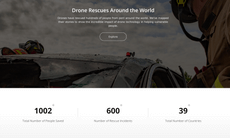DJI Urges Authorized Drone Users To Prepare For Hurricane Dorian
Rescue And Recovery Drone Operators Should Prepare Now For Post-Storm Operations;
All Other Drone Owners Should Follow FAA Guidance And Not Fly In Affected Areas
Editors: Photos and videos of airborne drones available at links below
August 29, 2019 – DJI, the world’s leader in civilian drones and aerial imaging technology, urges authorized drone users in the southeast United States to prepare their equipment and their operating procedures for the impending arrival of Hurricane Dorian. Other drone owners should follow U.S. Federal Aviation Administration (FAA) guidance and ground their aircraft during rescue and recovery operations.
“First responders and utility companies today rely on drones to help people during emergencies, and DJI expects our products will play a critical – even lifesaving – role in responding to this looming disaster,” said Mario Rebello, DJI Vice President and North America Regional Manager. “We want to make sure authorized drones can do their jobs safely and effectively in the days ahead, and that other drones stay out of rescuers’ way.”
Drones’ unique aerial perspective and ability to easily reach inaccessible areas have rapidly made them vital tools for first responders and infrastructure operators after hurricanes. Drones were first used widely for storm response after Hurricane Harvey struck Houston in 2017, where they were able to quickly inspect and assess infrastructure such as roads, bridges, railroads, power lines and oil refineries. In 2018, the North Carolina Department of Transportation flew more than 260 drone missions responding to Hurricane Florence, allowing them to assess damage, prioritize efforts on the ground, and plan safe routes for recovery workers.
Hurricane Dorian is projected to make landfall in central Florida on the morning of Monday, Sept. 2. Once it passes, drones are expected to play an important role in search and rescue, damage surveys, recovery planning, utility restoration and media coverage. Public safety agencies, utility operators, media outlets and other drone users with FAA authorization to fly DJI drones should prepare now to ensure they can fly in a chaotic post-storm environment without electricity or internet service.
DJI has unlocked its geofencing restrictions for drones operated by Florida Power & Light Company, which serves more than 10 million people across the state of Florida, and is working with other utilities which may be called in to assist recovery efforts. DJI is also working with Florida emergency management agencies and with DJI Enterprise dealers who serve first responders to quickly unlock geofencing for public safety drones in Florida.
Operators of DJI drones should ensure they have updated to the latest versions of firmware for their drones, batteries and remote controllers, as well as their flight control apps such as DJI Pilot and DJI GO 4. They should also ensure all batteries in all equipment are fully charged. Firmware downloads are available on the pages for each drone model at dji.com, and software and app downloads are available at dji.com/downloads.
Operators who may need to fly DJI drones in geofenced areas should apply to unlock those areas as soon as possible, since unlocking requires an internet connection:
- Public safety agencies in DJI’s Qualified Entities Program should already have geofencing unlocked.
- Other government agencies, as well as private operators with authorized missions, can apply to unlock geofencing at dji.com/flysafe/custom-unlock.
- DJI strives to respond to all unlocking requests as quickly as possible, and will prioritize requests from government agencies. DJI urges applicants to ensure all required documentation is complete and explicit, so it can be processed without the need for additional information.
The FAA approves emergency response drone flights following natural disasters through its Special Governmental Interest (SGI) process, which is open to applicants with existing Part 107 Remote Pilot certificates or Certificates of Waiver or Authorization. More information about obtaining SGI waivers is available at faa.gov/uas/advanced_operations/emergency_situations.
Drone owners who do not have FAA authorization to fly as part of Hurricane Dorian response and recovery should not fly in the aftermath of the storm. Airspace in affected areas will be crowded with low-flying helicopters and airplanes flying unusual patterns, temporary flight restrictions may be applied with little notice, and drone pilots who interfere with emergency response could face fines as high as $20,000.
Photos and videos of DJI’s Matrice 200 series drones used in search and rescue operations and power line inspections are available at these links:
Photos: dropbox.com/sh/xsqh7s6bl3ao2c5/AADqH8yMrJjMJohbtHtNhKPBa?dl=0
Videos: youtu.be/-ZeaqAWKvoY


